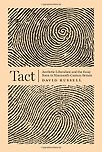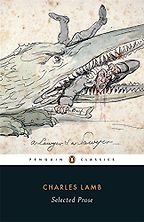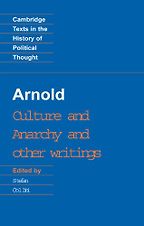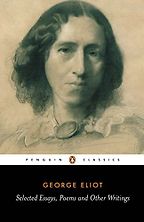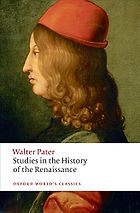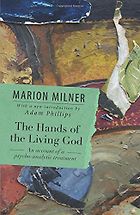Your recent book is titled Tact: Aesthetic Liberalism and the Essay Form in Nineteenth-century Britain. Today, we think of “tact” in terms of one’s sensitivity in dealing with difficult issues. But how did it emerge originally?
I was reading a lot of essays, particularly from the Romantic period. I noticed in my reading that the word ‘tact’ came up in slightly novel ways. It’s a word that existed in the eighteenth century, but less widely—it tended to mean a kind of refined ‘niceness’. There’s an air of politesse about the term. But by the early nineteenth century, it’s being used in new and interesting ways as a tactile metaphor for what people are doing with each other. Charles Lamb, for instance, is always telling stories about how people handle one another.
Contemporaries noticed the newness of this sense of handling others. The writer Sydney Smith wondered in a popular lecture why people now use metaphors of touch to describe their interactions. I wondered why this term ‘tact’ came about, and why it stayed with us as a social virtue today. Other words coined in response to social challenges of the the period didn’t take off: Bentham called his theory of education a ‘chrestomathic system’. We don’t still talk about ‘chrestomathic systems’, but we do still talk about tact in this way!
“By the early nineteenth century, ‘tact’ is being used in new and interesting ways as a tactile metaphor for what people are doing with each other. ”
We also see the essay performing a certain sensibility responding to social conditions and pressures associated with the beginnings of modernity in the nineteenth century. People are living more closely than ever before, with people they know less and less about. It’s city life, urban life. This idea that if you don’t know something about someone you encounter, what do you do with them? It becomes a much more open question. Through their tactful mode, these essayists come up with a creative rather than controlling, playful rather than violent ways of handling not only other people, but also the world and its objects.
What distinguishes the Victorian essay from its Romantic counterpart, or even from its earliest practitioners like Montaigne?
There’s a story here about a developing genealogy that I see beginning in the Romantic period, spurred on by these social changes and opportunities. It both adapts and turns away from eighteenth-century essays—say, the polite maxims and wit of The Spectator, which would come up with situations and rules by which to follow to solve particular social predicaments. Lamb often directly riffs off these scenarios, either to confound them or come up with less authoritative, more creative and playful responses to the same essential questions.
As the genealogy of the tactful essay goes through the nineteenth century, the social conditions seem less immediately present. Certain aspects remain pressing, such as the question of education, and how we influence one another in ways that involve progress or growth. But other elements such as the urban scene fall away, as in the essays of Matthew Arnold, or are transformed into imagined worlds, as in Walter Pater’s Renaissance.
Let’s move to your first choice. Why did you pick Charles Lamb, who is often seen as a minor, eccentric figure in the Victorian establishment?
Lamb is a figure who through the nineteenth century and early twentieth century became so sentimentalized. I thought something very important here is being defended against if sentimentality is being thrown over him in buckets. The more I read about Lamb, the stranger and more insightful I found him about social relations and aesthetic relations—the idea that they’re somehow the same thing.
“There’s a story about Thackeray pressing a volume of Lamb to his forehead and declaring, “Saint Charles!””
It was really the Leavisites that couldn’t stand him. And they were reacting to the High Victorian sentimentalizing of him. There’s a story about Thackeray pressing a volume of Lamb to his forehead and declaring, “Saint Charles!” But I came to find in his essays—for all their irony, or rather through their irony—a suggestive alternative to major questions of social life that were circulating around the same time as, say, the writings of the Utilitarians.
Lamb offers the essay form as a sociable, playful alternative to a systemizing insistence on transparency, information, and regulation as means of organizing how we live together. It’s a poetic response. Through essays like ‘Valentines Day’, ‘The Decay of Beggars in the Metropolis’ or ‘Distant Correspondents’, he produces a home in social, ethical and aesthetic life for what Keats calls ‘negative capability’—this idea that we can go through life without needing to know too much about others. Not knowing might open possibilities of creativity and a space between people. Attempting to get as much information as you can about others is limiting. It makes us overlook how interesting, strange and excessive other people are.
Who was Lamb’s audience at the time of writing these essays?
He’s writing in relatively inexpensive magazines in the early 1820s, such as the London Magazine. He was writing while holding down a really demanding job as a civil servant in the East India Company. He didn’t have a lot of free time. He wrote these pieces in evenings and odd days off, so they’re brief by necessity. But they’re very rich responses to the London of the early nineteenth century, and to the role of aesthetic experiences in ordinary life.
“Attempting to get as much information as you can about others is limiting. It makes us overlook how interesting, strange and excessive other people are.”
He was a deeply sociable and kind person who faced a lot of horror in his past. The famous story about Lamb (an origin of his saint-like reputation) is that he came home one day to find his sister had murdered their mother in a fit of psychosis. Rather than send his sister to a grim institution, he took on her full-time care. In spite of all this, Lamb managed to celebrate his own daily life and write about his environment so compellingly. He’s a counterpoint or alternative to the big ‘Lake School’ Romantics—Wordsworth, Coleridge, Southey—who could find the urban scene anathema to their poetic sensibilities.
So we’ll find the particulars of early nineteenth-century London in these essays. What makes them timeless?
Like Ruskin, Lamb really valued the way the vestiges and scars of the past endure in the social scene around him. It was one of his sources of tenderness for others. He’s a great appreciator of people, buildings and ideas that have somehow survived. His elegiac eye is valuable to us now, in a time when it seems there is less and less concern for the traces of the past in our present, and what they might mean to us. And one of the other timeless elements of Lamb’s essays is their delight in interactions with other people that surprise us. Essays can convey and model that delight in fresh and inventive ways.
Next, we have Culture and Anarchy and Other Writings. How is Matthew Arnold indebted to Romantic essayists like Lamb?
To go from Lamb—this rather playful, tentative, strong character, but also oblique character—to Arnold—this man with a reputation for being at the top of the Ivory Tower, a polite prophet of culture (a ‘kid-gloved Jeremiah’, as one of his detractors liked to put it)—seems like an unlikely move. But there’s a strong line of communication between them, partly because I think Arnold was for a long time misread and caricatured.
When critics have wanted to reject Culture with a capital-C as ideologically suspect, they’ve lumped Arnold in with F. R. Leavis, particularly in the twentieth century. But if you spend a lot of time with Arnold’s essays, you find what he’s really interested in is anybody’s creative sensibility and the conditions of culture in which an ordinary creativity is fostered and might flourish. At one point, Arnold says you could have it reading the newspapers; you don’t have to have it reading only the great classics. But because he says things like “the best that has been thought and said” and because Tory politicians nowadays quote him, they kind of miss what he’s saying. He’s not setting up a canon: he’s pointing out there could be more room for big ideas in a rather mechanical, commercialized, both moralistic and market-based existence. Arnold thinks that the creative freedom of ordinary ideas might serve as a basis for reorganising our own society.
Get the weekly Five Books newsletter
One of the connecting themes between Lamb’s and Arnold’s essays is the theme of education. Arnold was a school inspector. He scribbled essays on his breaks during visits to poor and provincial classrooms. He thought deeply about the forces in our culture that could democratize anybody’s ordinary creative experience – and not just for the wealthy and metropolitan. He was against models of education that were about training people for a specific role in a mechanical way—very anti what we might now call a purely ‘vocational’ education. In Collini’s edited collection, a late essay called ‘Equality’ (1878) is extremely important.
Why is ‘Equality’ so important?
This is one of the aspects of Arnold’s thinking that gets mislaid. Arnold’s is an economic model of equality in part. He praises the way recent events in French history have broken up and redistributed concentrations of wealth. This was an unusual thing for someone in Arnold’s position to say.
Importantly, what he’s arguing for is not an ideological substitute or a sop to conceal the real workings of political and economic power. He argued that aesthetic and sensory freedom is the basis for enthusiastic and creative response to life; which, in turn is the basis for an active engagement with one’s own society and culture—the basis of any politics. That’s why I refer to it in my book as something called an ‘aesthetic liberalism.’ It’s an alternative to models of liberalism contemporaneous with Arnold, such as the theories of John Stuart Mill. Arnold thought the richness of our aesthetic experience should be the very foundation of whether we can imagine a collective life worth living.
Arnold’s stance against vocational education seems to resonate with rise of neoliberalism in today’s universities. Would you say there’s a case for revisiting Arnold’s nineteenth-century models in our present moment?
I’d say there is. We could go back slightly further: Lamb is opposed to a model of human interaction that is based purely on the transfer of information. With recent debates about social media, particularly Facebook, Lamb may seem to be wiser than we thought!
“With recent debates about social media, particularly Facebook, Lamb may seem to be wiser than we thought!”
Arnold applies a tactful essayism to education. He makes a powerful case for thinking about education as the basis of feeling creatively alive in our own existence. Surely there’s no more important question to start discussions about education from, rather than what will it do for the economy; what will it do for elections? It’s a return to first principle questions—questions about values that we badly need today.
The fact that this is occurring in the essay form is probably interesting to think about as well—we see that the essay is neither purely creative nor philosophical. It seems to be a mixture of elements, at the heart of which is aesthetic experience. Given that, is it important to think about the categorization of the essay form? It’s not quite literature, not quite philosophy, not quite politics…
Yes, in telling Arnold’s story in my book, I realized it is about moving from poetry to the essay form, because the essay allowed Arnold to make a different kind of cultural intervention. I see the essay in this period as offering particular resources for performing new ideas about social relations. My line of approach to the essay is not the only one, but it emphasizes the way the essay is less invested in system and final knowledge. (Theodor Adorno said in 1958, “it is virtually the essay alone that has successfully raised doubts about the absolute privilege of method.”)
It allows for play; it allows for the tentative; it allows for not quite knowing where you’re going—the digression that could lead to a great insight. It provides a home for forms of creativity. The essay form should be relatively uncategorizable, or keep us on our toes. That’s how it keeps us interested.
The big elephant in the room is the Victorian novel. What is the nineteenth-century essay doing that the novel can’t, or do we see them working in league with each other?
That’s a good question, and I have various answers to it. One way to distinguish the essay from the novel is its brief suggestiveness, as opposed to seeking to immerse you in a whole world. The essay is not invested as the novel is in narrative, and conclusions from which a final judgment or valuation can be made of everyone who was in that novel from the retrospective (the bad guys are punished, and the good guys get married, and so on.) Whereas Lamb says “narrative teases me. I have little concern for the progress of events”; and he says he prefers to spend time with “oddities of authorship” and “heads with some diverting twist in them.”
“It allows for play; it allows for the tentative; it allows for not quite knowing where you’re going—the digression that could lead to a great insight. It provides a home for forms of creativity.”
That’s not to say there aren’t powerful essayistic elements or similar investments in major novels of the period. In Isobel Armstrong’s recent book, Novel Politics (2016), I find connections with some of these essay-writers. But to get those you have to read against the grain of the some influential ways of understanding the novel, which are about creating solid, all-too-plausible, bourgeois liberal subjects. That’s probably been overplayed, but it is a basis from which you can distinguish the much more vagrant and unclassifiable essay.
One good example of that might be found in your third choice, George Eliot. She’s the only major Victorian novelist on your list. Should we care about her essays as much as we do Middlemarch?
Her essays are fascinating. What struck me when writing about them was how un-tactful they are. Though she did return to the essay form at the end of her life, most of her essays are written in the 1850s before she turned to fiction. They’re a transitional form for her. Her essays often attempt to tear down various obstructions to what we might think of as a more tactfully created novel. One of her subjects—in her essay ‘Dr Cumming’—is a particular kind of evangelical religion which is all about condemning the world and announcing the end times. She thinks that’s a con and brilliantly demolishes its psychological logic.
‘Silly Novels by Lady Novelists’, one of the essays still often read, is a great example of what Eliot thinks of as a powerful cultural form not living up to its responsibilities. Though novels don’t have to be deadly serious and dry, they do have to be more fully responsible for representing the complexities of human life. She attacks the ways in which they aren’t. The essay becomes a weapon, a tool for accountability. Her targets are the cultural resources of her time, and how they let people down.
From around 1851 to 1856 she’s the unofficial editor for the Westminster Review—an unusual position to be in for a woman writer. How does being a standalone figure affect her essays?
She’s such a remarkable person that one is tempted to say she’s just a standalone individual. George Eliot is one of the great intellectuals of British history. It took a great deal of intellectual and moral courage to move to London when she did, and try and make her way in the world as a single woman in the field of journalism—which, of course, she was never credited for directly. Partly because of conventions of the time, but mainly because she was a woman.
“George Eliot is one of the great intellectuals of British history.”
Nevertheless, she had a great talent for finding those resources in the world which could lead to an interesting life. One of those resources became her partner, George Henry Lewes—leading to one of the great collaborative love-affairs of the century. At this time she is so attuned to the ways her world offers creative resources for her life, or fails to do this—her essays tend to express outrage at inadequate forms passed on through culture. She thought art and literature should help us to live.
In being purely reactive, she strikes me as about as far away from ‘tactful’ as one can be.
Yes, but this reaction produces the famous sympathy of her novels. In my book, I write about what happens in the transitions from her Westminster Review essays to her first full novel, Adam Bede. The themes of her essays are worked out in a positive way in her novels. It’s as if we’re seeing the grounds of or preconditions for an investment in tact—clearing the obstructions to it.
Sometimes, I think of George Eliot as a nineteenth-century version of Marilynne Robinson.
Yes! How formidable, uncompromising and invested in sympathy and forms of kindness those two are. It gets at an important distinction, which is that tactful sensibility is not invested in making everyone like one another. It’s not merely politeness.
Moving on to your fourth choice, Walter Pater’s Studies in the History of the Renaissance is a classic text of high aestheticism. Can you give us a brief account of its contents, and a sense of why it was so controversial when it first appeared?
The Renaissance, published in 1873, comprises a series of essay-portraits of Renaissance artists, mainly in France and Italy. The exception is that it ends with a portrait of a great eighteenth-century critic named Johann Joachim Winckelmann. Through these portraits, Pater offers us a whole sensibility—a way of appreciating the world.
The particularly rich form of living that these individuals model is condensed at the very end of the book in Pater’s famous conclusion, which is much-excerpted. It’s his manifesto or philosophy of intense experience, which immediately became a scandal.
“Pater was, like Socrates, accused of corrupting the young.”
Many of his readers were young and looking for the resources by which to have an interesting life, not unlike Eliot was when she was younger. They saw Pater was a writer who could really set them thinking about how to live a vivid life. The enthusiasm of undergraduates in Oxford at the time was part of the scandal: Pater was, like Socrates, accused of corrupting the young.
It was banned in Oxford, isn’t it?
Well, there were many scandalized reviews (George Eliot herself called the book “poisonous”!); and it was denounced by clergymen, in Oxford and Cambridge, in sermons and addresses. Pater certainly removed the conclusion from the next edition, but it was subsequently replaced with a slightly expanded version of The Renaissance which he felt justified and tempered what he’d originally said in the conclusion. The whole picture offered by Pater’s book is slightly different to the conclusion. Whatever the case, it cost Pater the chances of any promotion within the University. Though a Fellow at Brasenose College, he applied for various promotions and didn’t get them because he was seen as an undesirable figure.
Does that have anything to do with the homosexual undertones of the book, or is it more the sensual and erotic charge of its argument more generally?
Ultimately, we can’t distinguish one from the other. Certainly, there was a small scandal involving boys in Pater’s life. That was the other aspect of the scandal that surrounded him that cost him success in the normative world. But most of all, one of the messages of the book is about rejecting shame—of bodily or sensuous or aesthetic pleasure in the physical and material world. He talks about Winckelmann approaching Greek marble, saying “he fingers those pagan marbles with unsinged hands, with no sense of shame or loss.” That alone would be enough to have people turn a skeptical eye upon it.
There’s something about the way Pater wants to make the work of art come alive before the viewer’s eyes that I imagine must have been terrifying or disquieting.
The thing about Pater’s writing is that it’s the most astonishing prose you’ve ever read. It’s like nothing else. It divides people. It’s the kind of writing that would get thrown out of an American MFA program in a second. But Pater has an incredibly alive, exciting, and stimulating prose style that somehow transmits the excitement, the refinement and sheer imagination of his critical mind to the page.
Can you say a bit about why he ranges so far back in history, and so far afield into Europe? He’s probably the figure that goes further beyond London than any other on this list.
He’s trying to create his own genealogy of an enlivening, hopeful and vital sensibility. He’s not so interested in defining that sensibility according to set chronological parameters. His first readers found it very strange that he would begin an account of the history of the Renaissance in medieval France and end it in the eighteenth century, but what he does is provide an account of a rich sensibility that could happen at any moment at any time. It could happen to us, too—that’s part of the excitement of the book.
“Pater’s is the kind of writing that would get thrown out of an American MFA program in a second.”
That’s also why it ends with this stirring conclusion. His enthusiastic readers got the message that it was addressed to them. It wasn’t a dry, scholastic, closed off part of history. It was a question of a living, possible repertoire of relations by which we might be able to handle the world, if we chose to take it on. That’s why it’s connected to this broader question of a history of tact.
What an interesting connection—the timelessness of both The Renaissance, which isn’t bound by historical period, and Pater’s injunction to the reader in the conclusion.
That’s right. For Pater, the essay provides other forms of continuity than dates, because writers and artists speak to us across time.
Your last book by psychoanalyst Marion Milner is the only one of the five from outside the nineteenth century. What does Milner have to offer a consideration of the Victorian essay?
One of the reasons I turn to a twentieth-century psychoanalyst is that I see in Milner’s work an inheritance of this essayistic, tactful tradition. This is also more broadly true of those psychoanalysts around her, known as the ‘Middle Group’, including D.W. Winnicott and Wilfred Bion.
These thinkers respond to the influence of psychoanalytic theory arriving in Britain from Germany and Austria. So before, during and after the Second World War in Britain, we have a group of psychoanalytic thinkers who take aesthetic experience very seriously as part of any model of psychological health. They’re prone to approach mental suffering according to questions of whether people feel they have a sufficient capacity for play and creativity in their lives. We see a rich example of how art, psychology, ethics and even politics all stem from a literary tradition. They weren’t trammeled by overly narrow ideas of scientific rigor. They were suspicious of the way that we can reduce experience through a need for certainty. Indeed, they viewed it as one of the sources of human suffering.
“They were suspicious of the way that we can reduce experience through a need for certainty. Indeed, they viewed it as one of the sources of human suffering.”
I could have chosen any of Milner’s books. She starts out as an essayist in the 1930s with a couple of books about diary-keeping, which have been compared to Woolf and other modernists thinkers. She then trained as a psychoanalyst. She’s best known, perhaps, for a book she wrote called On Not Being Able To Paint (1950), which is all about her own investigation of the sources of her own creativity through techniques of free-drawing. It’s fascinating.
Get the weekly Five Books newsletter
The particular book I chose is an account of a long case history between Milner and a very unwell woman she names ‘Susan’, who relatively early on in the treatment isn’t benefitting from the cleverness of psychoanalysis and its theories. Together, Milner and Susan change tack. By communicating through drawing, they approach more fundamental questions about what it feels like to be in the world.
The title—The Hands of the Living God (1969)—evokes this quote from D. H. Lawrence: “It is a fearful thing to fall into the hands of the living God. But it is a more fearful thing to fall out of them.” That speaks so beautifully to this idea of tact in the essay form.
It really does. It’s a modification of its Biblical origin as if to suggest, we’re in the world—there’s no cure for that. We’ll never be able to escape the responsibility of having our life and others’ lives in our hands; that’s both a strain and a pleasure. But to attempt to evacuate the whole question to search for forms of certainty that will inoculate us against other people is so much worse.
Milner begins by saying that Susan is a woman who has “lost her soul; that the world was no longer outside her; and that all this had happened since she received E.C.T. in the hospital”. The book spans twenty years of treatment, and at the end Susan writes in her diary: ‘I am in the world for the first time for sixteen years.’ Am I right in thinking the subject is habitation—of finding a way of living?
Yes, that’s a great way of putting it. What Milner and Susan together call “finding a baseline for one’s existence”, or what Winnicott calls “somewhere to be going on from.” This embodied sense of one’s own place in the world with others is not something that comes naturally; in fact, it’s part of our personal history that we’ve developed this feeling.
Is it an important distinction to make that the play advocated here and in the essay form isn’t necessarily free and spontaneous, but cultivated intensely as an art?
Well, one of the questions of the book is that if someone is suffering from the lack of a capacity for spontaneity, how can they gain it? It’s a very difficult and fascinating question. Milner has interesting insights about this. One is her concern with how we define and cultivate the space between people. This insight leads to what Winnicott would later call “transitional space”: the quality or the richness of an area of interaction of which, if we only think of people as sealed-off individual units, we never gain any sense of this.
Is she the apotheosis of the thinkers we’ve been discussing, or is she an interesting counterpoint to Lamb, Arnold, Eliot and Pater?
I would say she makes wonderful uses of a profound literary tradition. Everybody should read her. Her prose style is warm, accessible and surprising all at once. Her thinking about the way we can take seriously the quality of our own daily experience and its joys, its forms of pleasure. One of the great Romantic sources for Milner was Blake. The question central to both of how important it is to feel joy, and how it’s a basis for social and political ideas, is extremely timely today.
Five Books aims to keep its book recommendations and interviews up to date. If you are the interviewee and would like to update your choice of books (or even just what you say about them) please email us at [email protected]
Five Books interviews are expensive to produce. If you've enjoyed this interview, please support us by donating a small amount.

